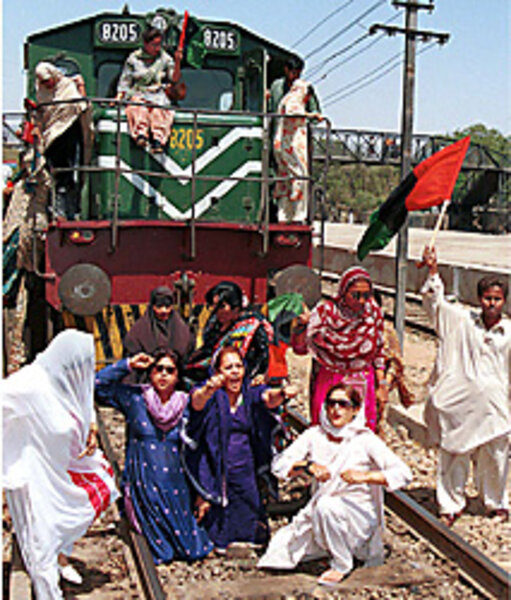Bhutto's rise carved path for Pakistani women
Loading...
| Karachi, Pakistan
When Tourism Minister Nilofer Bakhtiar came under attack from hard-line clerics after she was photographed embracing a man in public, Benazir Bhutto was quick to defend her.
"Benazir and I grew close when she issued a strong statement from Dubai in my favor. Her words were very encouraging because at that time, even my own party was not giving me any support and was, instead, asking for me to step down."
Ms. Bakhtiar eventually kept her position in the government but the controversy that stemmed from the May 2007 photo and an ensuing fatwa from fundamentalist clerics illustrates the ongoing struggle for many Pakistani women, especially for those who step beyond traditional roles to lead public lives.
It was a tension that followed Ms. Bhutto's career to the very end as an influential figure who broke the gender barrier here to become prime minister and along the way inspired a generation of female Pakistani leaders.
When Bakhtiar was just starting out in politics, Bakhtiar remembers how she "used to look up to Bhutto as the only strong female leader in Pakistan."
But now the tourism minister, who was previously president of the women's wing of the Pakistan Muslim League, Quaid-e-Azam, which opposes Bhutto's Pakistan People's Party (PPP), worries that middle-class women who may have been considering careers in politics will think twice before signing up.
"Women are going to think that you have to be extraordinary and exceedingly brave to enter politics ... and that will keep them away," she says.
Many female politicians and analysts here say that it was Bhutto's ability to transcend the politics of gender that enabled her to rise to the top.
The restoration of democracy, poverty reduction, and the threat posed by religious extremism were her core issues. As Ali Dayan Hasan, South Asia researcher for Human Rights Watch (HRW) puts it, "Benazir was a politician, not a women's rights activist."
And indeed, Bhutto was regularly critiqued for failing to improve the status of Pakistani women through policy initiatives or legislation. She disappointed activists when she did not repeal the Hudood and Zina ordinances, laws that impede women's rights and indict rape victims on the charges of adultery.
Hina Jilani, a human rights activist who cofounded the first all-female legal practice in Pakistan, complains that Bhutto never "showed the political commitment to addressing legal discrimination against women."
In Bhutto's defense, HRW's Mr. Hasan points out that "to the extent that she could bring pressure to bear to ensure that the rights of women and minorities were upheld, she did."
He recalls that during Bhutto's terms in office, the trials of raped women facing adultery charges and members of religious minorities accused of blasphemy were expedited, and often decided in the defendant's favor.
There is no denying that Bhutto expanded the scope of women's involvement in Pakistani politics. She escaped charges of tokenism by appointing several women to prominent positions within the PPP.
"Benazir was a rare woman who saw the other women around her as an asset," explains Sherry Rehman, the PPP information secretary. "She personally mentored and trained many of us and encouraged us to be in mainstream positions rather than on the sidelines."
It is a testament to the tenacity of the women in the PPP that Ms. Rehman is the most vocal office bearer contesting the Pakistan government's analysis of the cause of Bhutto's death. Her insistence that Bhutto died of bullet wounds – rather than a head injury, as is claimed by the interior ministry – has sparked a major controversy and complicated theories about who may be behind Bhutto's assassination.
Bhutto also initiated a nationwide rural women's health program that employed more than 50,000 female health workers to provide basic healthcare and family planning education. She appointed the first female judge to a high court in Pakistan, established women's police stations, and launched the First Women's Bank of Pakistan, which offered credit, and thus economic empowerment, to women from all socioeconomic backgrounds.
As a result, gender activist and documentary filmmaker Beena Sarwar claims that she "felt a lot safer as a woman during Bhutto's time than under other governments."
But for all her attempts to engage women at the grass-roots level, Bhutto's Ivy League education and ties to a political dynasty kept her removed from the average Pakistani woman.
It remains telling that when Bhutto first came to power in 1988, she won a seat to parliament from Peshawar, a victory based on the votes of men in a city where women continue to be discouraged, or outright prevented, from casting ballots.
Zohra Yusuf, the vice chairperson of the Human Rights Commission of Pakistan in Sindh, suggests, "Most women thought of Benazir as a different entity, in spite of her popularity. They probably didn't identify with her."
For her part, though, Jilani says that although women did not emulate Bhutto, they gained a trickledown confidence from her powerful position.
"In the late 1980s," she recalls, "women in the workplace, like nurses and telephone operators, had been hearing for two decades that there was no space for them in the public domain. They were on the defensive and knew they were fighting a losing battle against social censure. But when Benazir came into power, they reclaimed their right to enter the public domain."
If anything, Bhutto’s public life as both prime minister and embattled political heiress broadened the outlook of many women. Shazia Marri, a provincial leader and PPP member, says it was often solely the way in which she balanced her roles as daughter, sister, wife, and mother that was seen as remarkable.





